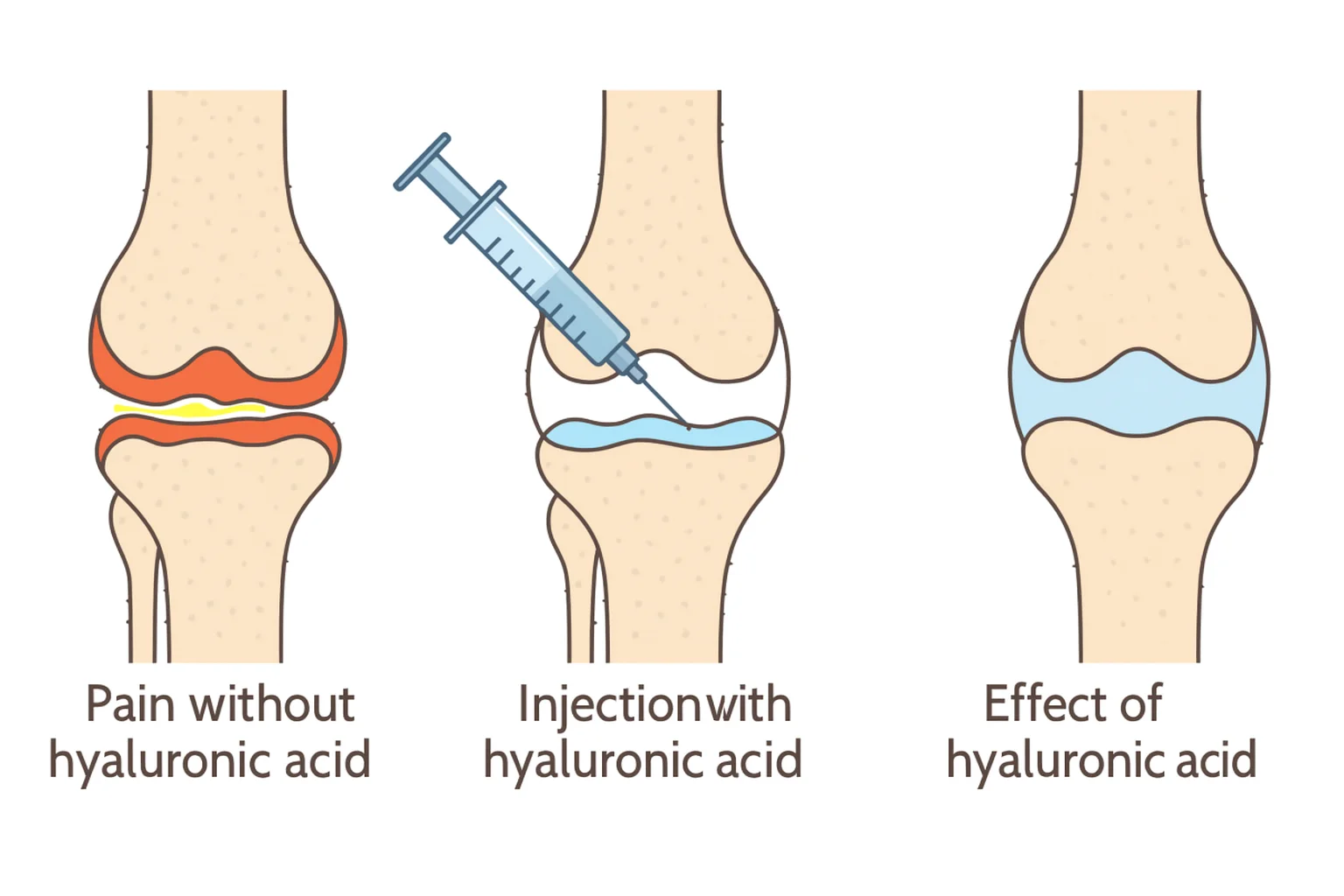Suitable for knee pain and osteoarthritis Hyaluronic Acid Injection – Mechanism & Evidence TrHCROSS 2.0% provides relief for knee osteoarthritis


Product
Choose TrHCROSS 2.0% hyaluronic acid injection via our webshop. It is CE-certified and meets all medical safety standards. You can order easily with or without an account.

Treatment
After ordering, you will receive clear instructions on administration. You can consult your treating physician or an affiliated medical specialist. The injection is administered intra-articularly (into the knee joint).

Aftercare
After the injection, it is important not to strain the knee for 1–2 days. Avoid intensive exercise. Light movements can be resumed after consultation with your physician.

Long-lasting results
Many users experience pain relief and improved mobility within a few weeks. In mild to moderate osteoarthritis, the effect can last up to 6–12 months. Read below.
Mechanism of hyaluronic acid injection in knee osteoarthritis
Application of TrHCROSS 2.0%
The hyaluronic acid injection we offer, TrHCROSS 2.0%, is an innovative, cross-linked form of hyaluronic acid that provides long-lasting relief from knee osteoarthritis with a single injection. The injection is administered directly into the knee joint by a physician or medical professional.
How the injection is performed:
- A medical assessment is carried out in advance (with ultrasound guidance if required)
- The joint is cleaned and prepared locally
- The injection is administered intra-articularly (into the joint)
- After the injection, rest is advised for 24–48 hours
How does a hyaluronic acid injection help the knee?
Hyaluronic acid is naturally present in the synovial fluid of the joints. In osteoarthritis, its concentration decreases, making the joint drier and stiffer.
- Restores the viscosity of the joint fluid
- Lubricates the joint, allowing smoother movement
- Absorbs shocks, reducing pressure on the cartilage
- Forms a protective layer on the cartilage (coating effect)
- Acts as an anti-inflammatory in mild inflammatory processes
Benefits of hyaluronic acid injection
Side effects
In addition to the desired effect, a medicine can also cause unwanted side effects. Although not everyone experiences them, it is important to seek medical help if they occur.
Contact your doctor or nurse immediately if you experience any of the following side effects:
Common side effects:
- Difficulty moving
- Muscle pain or stiffness
- Joint pain
Less common side effects:
- Swelling or redness in the joint
Some side effects are mild and usually disappear on their own during treatment, as your body adjusts to the medicine. Your healthcare provider may also advise you on ways to prevent or reduce these side effects.
Contact your doctor if any of the following side effects persist or become bothersome:
Less common local reactions:
- Bleeding, blistering, burning sensation
- Cold sensation, skin discoloration
- Pressure, hives
- Infection or inflammation
- Itching, nodules, numbness
- Pain, rash, redness
- Scarring, tenderness, stinging sensation
- Swelling, tingling
- Ulcers or warmth at the injection site
- Other side effects not listed here may also occur.
If you experience other complaints, contact your doctor or healthcare provider.
Allergies
-
The effect depends on the degree of joint wear (osteoarthritis severity)
-
Not everyone experiences improvement (about 50–60% report long-term relief)
-
Temporary pain or swelling may occur after the injection
-
Allergy to bacterial proteins (gram-positive bacteria)
-
Allergy to hyaluronate preparations
-
Infections or other skin or knee joint problems at the injection site – This medicine must not be administered to patients with these conditions.
-
Joint effusion (excessive amount of fluid in the knee joint) – This condition must be treated first before this medicine can be administered.
Scientific evidence for hyaluronic acid injections in knee osteoarthritis
Clinical studies have shown that intra-articular hyaluronic acid injections are effective in mild to moderate knee osteoarthritis. They relieve symptoms by mimicking the natural function of synovial fluid. According to Bannuru et al. (2019), viscosupplementation is safe and can delay the need for total knee replacement by an average of two years with regular use.
Large database study: An American analysis showed that hyaluronic acid injections can delay the time to total knee replacement by several years (Altman et al., 2015). In addition, research published in Osteoarthritis and Cartilage confirms that cross-linked formulations such as TrHCROSS 2.0% have a longer duration of action than standard hyaluronic acid preparations, as the molecules break down more slowly.
Comparative research: In a laboratory study, TrHCROSS® clearly emerged as the most stable product. It showed the highest resistance to enzymatic degradation and can therefore remain active longer (del Olmo et al., 2023). The active substance in our injection is a synthetically produced, purified form of hyaluronic acid free of animal components, minimizing the risk of allergic reactions.
Real-world experience: Data confirm that even in advanced knee osteoarthritis, a single injection can provide significant pain reduction and improved mobility (Acín et al., 2025).
Comparison of hyaluronic acid products (del Olmo et al., 2023)
| Hyaluronic acid product | Type & Technology | Resistance to degradation |
|---|---|---|
| TrHCROSS® 2.0% | Cross-linked HA – SARE® technology | ⭐⭐⭐⭐⭐ Highest tested (del Olmo et al., 2023) |
| Durolane® | Cross-linked HA – BDDE | ⭐⭐⭐ |
| Monovisc® | Cross-linked HA – BDDE | ⭐⭐ |
| Regenflex® Bio-plus | Cross-linked HA – modification | ⭐ |
Mechanism of hyaluronic acid
When hyaluronic acid is injected into the knee joint, it mixes directly with the synovial fluid, the natural lubricant of the joint. Hyaluronic acid is a long chain of sugar molecules with strong water affinity, which increases the viscosity and elasticity of the synovial fluid. This results in better lubrication and more effective shock absorption during movement, reducing friction and mechanical damage between the joint surfaces.
In addition, hyaluronic acid binds to specific receptors on joint cells, such as CD44. This interaction plays a key role in reducing inflammatory processes. By inhibiting pro-inflammatory substances such as cytokines and enzymes that break down cartilage, hyaluronic acid helps limit further damage. It even stimulates chondrocytes to produce their own hyaluronic acid and collagen, supporting cartilage repair and preservation.
An important benefit is pain reduction. By improving lubrication and reducing inflammation, it decreases irritation of nerve endings in the joint, leading to significant pain relief and improved mobility. This enables patients with knee osteoarthritis to move more comfortably and with less pain.
In summary: hyaluronic acid injections act on multiple fronts – lubrication, anti-inflammation, cartilage protection, and pain relief.
Key factors influencing the effect:
- Severity of osteoarthritis
- Presence of joint fluid
- BMI and general health condition
- Lifestyle (e.g., smoking, activity level)
Scientific organizations such as the Arthritis Foundation, Mayo Clinic, and OARSI confirm that hyaluronic acid injections are safe and a valuable treatment option in the management of knee osteoarthritis, especially for patients who wish to avoid or cannot tolerate cortisone injections.
Summary in biochemical phases
| Phase | Physiological process |
|---|---|
| Injection into synovial fluid | Hyaluronic acid mixes with joint fluid |
| Increase in viscosity | Binds water, increases lubrication and elasticity |
| Binding to cell receptors | CD44 and RHAMM receptors on synovial cells and chondrocytes |
| Inhibition of inflammatory cytokines | Reduces IL-1β, TNF-α, and MMP production |
| Cartilage repair stimulation | Promotes production of endogenous hyaluronic acid and collagen by chondrocytes |
| Pain relief | Dampens nociceptive fibers and reduces local inflammation |
| Cartilage protection | Physical barrier and reduced enzymatic breakdown |


